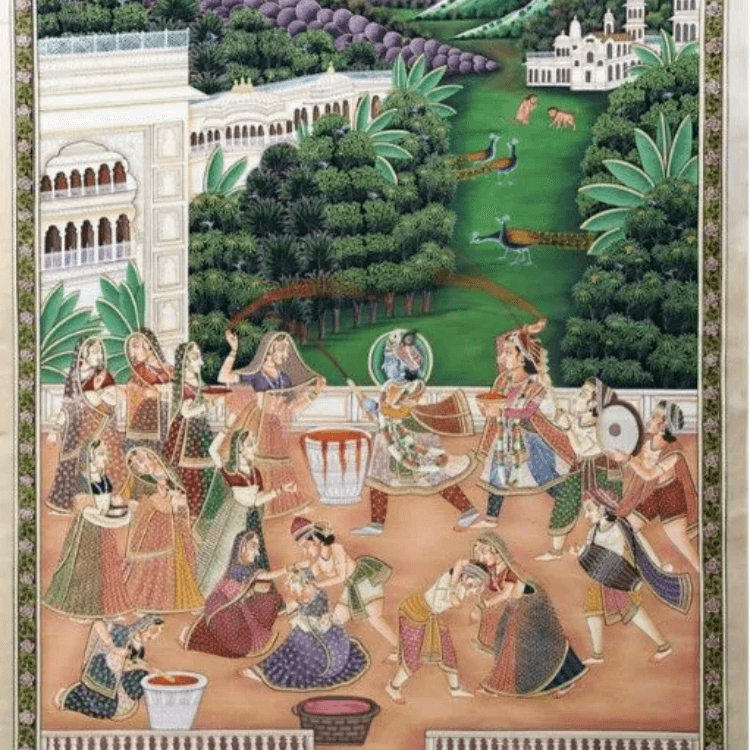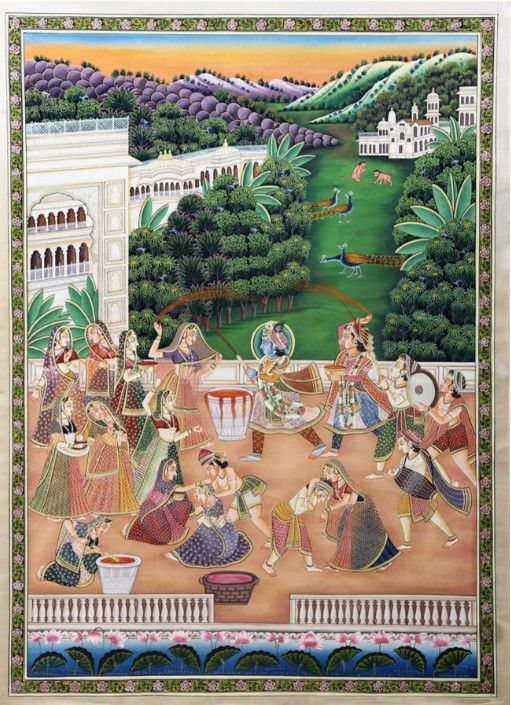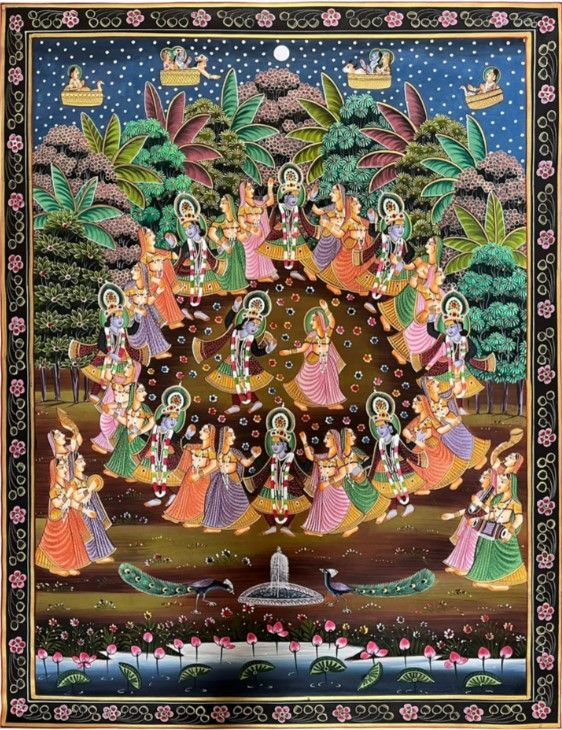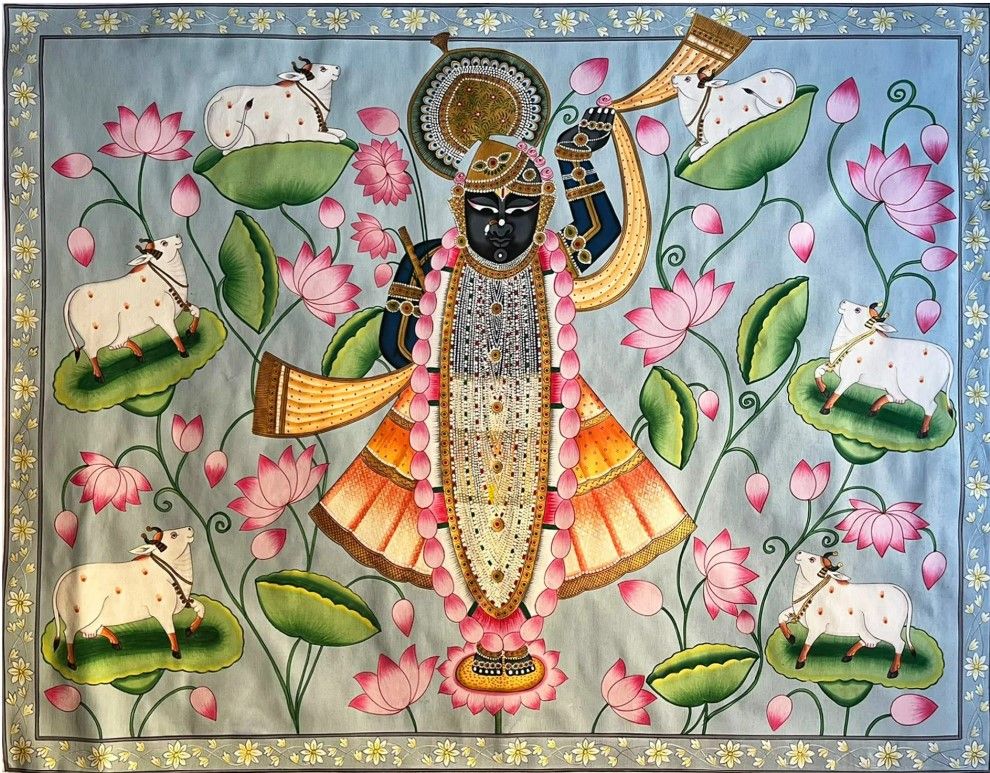
Your Cart
The Art of Pichwai Paintings

Pichwai painting is a form of traditional Indian art that originates from the state of Rajasthan. These paintings, which portray the life and tales of Lord Krishna, are renowned for their minute details and vivid colours. Accordingly, these paintings were initially made to serve as the background for Lord Shirnathji. He is a manifestation of Lord Krishna as a child. These paintings were originally utilised in the Shrinathji temple of Nathdwara.
**History** -----------
The history of Pichwai art traces back to the 17th century. At Nathdwara, a town well-known for its Shrinathji temple, the art form was used to adorn the walls of temples. The paintings portrayed numerous events from Lord Krishna's life. They were created using natural paints and dyes.
Artists from the Chippa tribe, renowned for their skill in designing textiles, have historically produced Pichwai paintings. Pichwai paintings matured and got more intricate as their recognition increased. Beginning with the lotus flower, peacocks, and cows, all connected to Lord Krishna, the paintings started to include rich elements and symbolism. Also, the painters began experimenting with other approaches and methods, including Rajasthani and Mughal themes.

**Techniques and Styles** -------------------------
The techniques used in Pichwai painting are highly distinctive and call for high talent and patience. Pichwai paintings employs a variety of techniques and styles, each of which is remarkable in its own way. The following are some of the most used methods for creating Pichwai paintings:
- Block Printing: This technique involves using wooden blocks to create designs on the fabric. The blocks are dipped in natural dyes and then pressed onto the fabric to create the desired pattern.
- Hand Painting: This technique involves using natural pigments and dyes to paint the designs onto the fabric. The artists use a brush to create intricate details and patterns.
- Embroidery: This technique involves using threads to create designs on the fabric. The threads are woven together to create intricate patterns and details.
Pichwai paintings' unique features are their distinctive styles, which change based on the area and the artist. Some of the most popular styles include:
- Nathdwara Style: Intricate details and vivid colours define this style. The paintings frequently have a black background which highlights the colours.
- Jaipur Style: The use of gold foil and the delicate detailing define this style. The paintings frequently show incidents from Lord Krishna's life, such as his youthful mischief and his love for Radha.
**Themes** ----------
Pichwai paintings are made to grace temple walls and serve as backdrops for religious occasions and celebrations. They usually feature scenes from Lord Krishna's life. The following are some subjects that frequently appear in Pichwai paintings:
- Childhood of Lord Krishna: The paintings depict various events from his childhood, such as his playful interactions with his friends and his love for butter.
- Ras Leela: The paintings depict Lord Krishna's interactions with gopis and the Ras Leela dance.
- Govardhan Puja: Celebrating Lord Krishna's victory over the God of Rain, Pichwai paintings depict Lord Krishna lifting the Govardhan hill on his little finger to protect the villagers from the heavy downpour.
- Radha-Krishna: The paintings capture the intense love and devotion between the two and are believed to represent the ultimate union of the individual soul with the divine.

**Significance** ----------------
Pichwai painting is a traditional art form of India that holds significant cultural and religious importance. Here are some of the cultural significances of Pichwai paintings:
- Depiction of Lord Krishna's Life: Pichwai paintings are primarily created to depict the life and teachings of Lord Krishna. The paintings capture various aspects of Lord Krishna's life, including his childhood, his interactions with gopis, and his love for Radha. These paintings are not just visual representations of Lord Krishna's life, but they also serve as a medium for devotees to connect with the divine.
- Historical Significance: Pichwai paintings originated in Nathdwara in Rajasthan in the 17th century. The paintings were used to decorate the walls of temples and were used as backdrops during religious ceremonies and festivals. The paintings, therefore, hold significant historical importance as they offer insight into the rich cultural heritage of Rajasthan.
- Devotional Art: Pichwai paintings are considered a form of devotional art. The paintings are often used in temples and homes to express devotion to Lord Krishna. These paintings are believed to bring prosperity, peace, and happiness to the place where they are kept. They also serve as a medium for devotees to meditate and connect with the divine.
- A Reflection of Traditional Indian Art: Pichwai paintings are a beautiful example of traditional Indian art. The paintings are created using natural pigments, and the process of creating these paintings involves a high level of skill and attention to detail. Pichwai paintings are known for their intricate details, vivid colours, and the use of gold and silver foil to add a shimmering effect to certain parts of the painting.

Conclusion ----------
Pichwai paintings are a Rajasthani cultural treasure and a homage to Lord Krishna. Not only has this traditional art form helped to maintain Indian cultural traditions, but it has also given the Rajasthani people a way to express their devotion. Pichwai paintings' elaborate patterns and vivid colours have won recognition on a global scale and have been displayed in galleries and museums all over the world. For the Rajasthani people, Pichwai painting is a way of life as well as an art form, and it will continue to amaze and inspire people for many centuries to come.
Know more about such Indian traditional art with Rooftop.
If you love Indian art and Indian art history, visit our Instagram on @rooftop_app or download the Rooftop App from GooglePlay or AppStore and try out our workshops and courses.